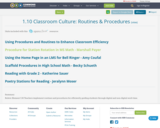
Rubric Element 1.10 Teachers implement routines and procedures for efficiently guiding students through digital and non-digital work time.
- Subject:
- Education
- Material Type:
- Primary Source
- Date Added:
- 07/20/2018

Rubric Element 1.10 Teachers implement routines and procedures for efficiently guiding students through digital and non-digital work time.

In this Wonder of the DayR, we learn about why flamingos are pink. Students have the opportunity to explore the Wonder either as a class or individually. With suggestions for different age groups, Wonder #1 has an activity to engage students with drawing, writing description, or both.
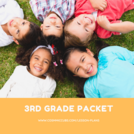
This packet assists parents and teachers transition to distance learning.
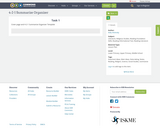

In fifth grade unit 5, Reading Historical Fiction Book Clubs, students will be organized into reading clubs consisting of 3-5 students of similar reading levels as they read historical fiction text set made up of related historical fiction, informational text and primary sources (photographs, letters, posters etc.) How do readers read, analyze and interpret historical fiction text? to understand their historical fiction and the time period connected to the text.
Summarize a written text read aloud or information presented in diverse media and formats, including visually, quantitatively, and orally. Determine central ideas or themes of a text and analyze their development; summarize the key supporting details and ideas.
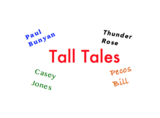
This lesson uses tall tale read alouds to reinforce the common elements, or text structure, of tall tales. As the text is read aloud, students examine the elements of the book that are characteristic of tall tales. Then using what they've learned, they write and perform tall tales of their own.
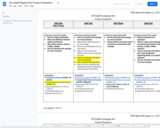
6th Grade Regular English Language Arts: Course Scope & Sequence.
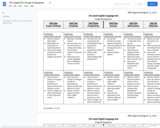
7th Grade Regular English Language Arts: Course Scope & Sequence.
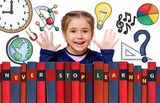
Students will be able to ask and answer questions about key details in a text. Students will be able to compare and contrast the adventures and experiences of characters in stories.
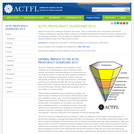
This resource gives detailed proficiency guidelines for second language learners in the four major categories of speaking, writing, listening, and reading. It separates proficiency into five major levels: distinguished, superior, advanced, intermediate, and novice. Advanced, intermediate, and novice are further divided into high, mid, and low sublevels. The guidelines give detailed descriptions of language use regarding each level, applicable to all languages.
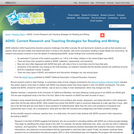
This article provides an overview of current research about attention deficit hyperactivity disorder as well as strategies to help students with ADHD with reading and writing.
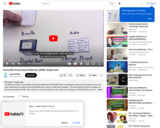
The National Center on Accessible Instructional Materials and PACER Center are pleased to announce the release of our new video explaining Accessible Instruc...

A wiki textbook collaboratively authored in two main sections: financial accounting and managerial accounting.

Uses annual reports of real companies to illustrate many of the accounting concepts in use in business today. Gaining an understanding of accounting terminology and concepts, however, is not enough to ensure your success. You also need to be able to find information on the Internet, analyze various business situations, work effectively as a member of a team, and communicate your ideas clearly. This text was developed to help you develop these skills.
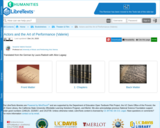
Performance Philosophy is an emerging interdisciplinary field of thought, creative practice and scholarship. The Performance Philosophy book series comprises monographs and essay collections addressing the relationship between performance and philosophy within a broad range of philosophical traditions and performance practices, including drama, theatre, performance arts, dance, art and music. The series also includes studies of the performative aspects of life and, indeed, philosophy itself. As such, the series addresses the philosophy of performance as well as performance-as-philosophy and philosophy-as-performance.
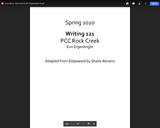
Adaptation of Empoword by Shane Abrams. Link to original text: https://pdxscholar.library.pdx.edu/pdxopen/20/
This adaptation slims down the original by cutting student texts, activities, assignments, and the metacognitive section. Intended for use as a reader.
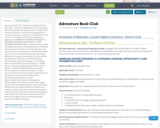
Adventure Book Club - The Boxcar Children
By: Rose Wehrman - University of Nebraska-Lincoln Copyright 2018 by Rose Wehrman under Creative Commons Non-Commercial License. Individuals and organizations may copy, reproduce, distribute, and perform this work and alter or remix this work for non-commercial purposes only.
NEBRASKA HONORS PROGRAM CLC EXPANDED LEARNING OPPORTUNITY CLUBS INFORMATION SHEET:
Name of Club: Adventure Book Club
Age/Grade Level: 3rd Grade
Number of Attendees: (ideal number) 8 or fewer
Goal of the Club: (learning objectives/outcomes) Jumpstart critical thinking skills, improve literacy, and encourage students to engage with books
Resources: (Information for club provided by) The Boxcar Children, various Pinterest ideas
Content Areas: (check all that apply)
☐ Arts (Visual, Music, Theater &Performance)
☒ Literacy
☐ STEM (Science, Technology, Engineering &Math)
☐ Social Studies
☐ Wellness (Physical Education, Health, Nutrition &Character Education)
Outputs or final products: (Does the club have a final product/project to showcase to community?) Building a boxcar diorama/dog toys donated to animal shelter/completion of book
Introducing your Club/Activities: This Adventure Book Club engages students with the community, each other, and reading.
General Directions: Read The Boxcar Children and integrate hands-on activities to help students connect to the story, think critically, and build interdisciplinary skills.
Tips/Tricks: Watch for when students start to become disengaged. Have an intentional activity prepared for when this happens.
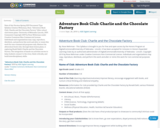
Date of this Version
Spring 2019
Document Type
Syllabus
Citation
Wehrman, Rose. "Adventure Book Club: Charlie and the Chocolate Factory." After school club lesson plans. University of Nebraska-Lincoln, 2019.
Comments
Copyright 2019 by Rose Wehrman under Creative Commons Non-Commercial License. Individuals and organizations may copy, reproduce, distribute, and perform this work and alter or remix this work for non-commercial purposes only.
Abstract
An afterschool book club, through these lesson plans, is exploring Roald Dahl's Charlie and the Chocolate Factory. The integration of hands-on activities serves to help students connect to the story, think critically, and build interdisciplinary skills.
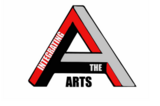
This resource was created by Sandra Schueler, in collaboration with Dawn DeTurk, Hannah Blomstedt, and Julie Albrecht, as part of ESU2's Integrating the Arts project. This project is a four year initiative focused on integrating arts into the core curriculum through teacher education, practice, and coaching.

This lesson is to get students familiar with all aspects of Space Exploration. They will have an understanding of the sun, planets, and satellites. This lesson is interactive with a video and space jeopardy.